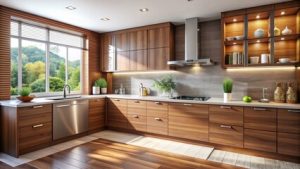Cabinet refacing is a smart, high-impact kitchen upgrade that offers the same stunning results as a full remodel but for less cost and hassle. Get ready to fall in love with your kitchen again with Sacramento Cabinet Refacing.
With endless options in door styles, finishes, and hardware, refacing allows you to create a custom look with timeless appeal.

Beadboard Cabinet Faces
Kitchen cabinet styles play a major role in how your home looks and feels. Whether you’re going for a modern farmhouse, cottage chic, or transitional style, your cabinet door designs are the key element that will set the tone for your entire kitchen design. Fortunately, updating your cabinets doesn’t have to mean full replacements or complicated remodels. Smart DIY projects like adding beadboard cabinet faces can create a high-impact style upgrade for under $300.
Beadboard is a versatile and timeless cabinet material that adds texture to your kitchen. It’s a popular choice for farmhouse, coastal cottage, and transitional kitchen designs and works well with both stained and painted finishes. The vertical lines of beadboard visually expand rooms and introduce a custom flair that’s hard to replicate with builder-grade cabinetry.
If you’re looking for something a little more modern, consider adding beadboard doors with wider bead spacing to give your kitchen a crisp, clean look. This more minimalist beadboard cabinet style is a great alternative to the traditional raised panel door, and it pairs beautifully with sleek hardware for an updated look.
A fresh coat of paint can be the most cost-effective and impactful way to transform your kitchen. Choose from a variety of hues and sheens to complement your space, from matte to glossy, and experiment with accent colors that work with your home’s overall aesthetic.
Wood veneer is an eco-friendly and durable option that combines the best of both worlds: natural wood beauty with enhanced stability. Using thin layers of real wood over a core, you get gorgeous grain patterns without the maintenance concerns of solid wood. You can also opt for a laminate wood finish if you’re on a budget or prefer to skip the upkeep.
If you’re ready to take your DIY project to the next level, contact us today for a free estimate and consultation! We’ll use our advanced technology to apply your new cabinet refacing project in just 3-5 days, delivering superior results that will last for years to come. Our experienced team will provide you with expert guidance to ensure your kitchen renovation meets your exact specifications, and our flexible financing options make the upgrade process even easier.
Shaker Cabinet Faces
Cabinet doors are far more than functional components that conceal and organize pantry items; they’re the very face of your kitchen, dictating its style and ambiance. They can be timeless, trendy, or classically elegant, reflecting your tastes and design philosophy. This is why cabinet fronts are one of the most pivotal choices you can make during a remodel or refresh project.
The Shaker door is a simple, timeless design that fits seamlessly into any kitchen style. It is most commonly found in traditional kitchens, but can also be incorporated into transitional and modern styles. It is a popular choice for homeowners who want to showcase their wood grain or natural finishes.
This cabinet door is often produced from solid hardwood, but can also be manufactured using MDF (medium-density fiberboard). It can be painted or stained, and glazed or unglazed to suit your kitchen’s aesthetic. It can be installed using either full overlay or inset styling.
It’s recommended to pair your shaker cabinets with simple hardware like cup pulls and classic knobs to create a classic, balanced aesthetic. You can even add a subtle sophistication to your Shaker doors by opting for an edge treatment, such as a sophisticated bevel design.
A bevel detail elevates the look of a cabinet door by creating an intricately defined line of light around the perimeter of the frame. This design detail is subtle, but it enhances the beauty of the Shaker door’s clean lines.
Another option for enhancing the look of your shaker cabinetry is incorporating frameless construction, which eliminates a face frame and shows off the innate simplicity of this cabinet style. Frameless cabinetry can be paired with shaker doors for a sleek contemporary aesthetic or used to complement more traditional kitchen designs.
When shopping for new cabinet fronts, it’s important to compare prices and quality. You can save money by purchasing cabinet doors and drawer fronts online or by working with a specialized company that offers refacing services. Before you commit to any company, research online reviews and check references. Make sure your quotes itemize materials, installation labor, and hardware, as well as any tear-out or disposal costs.
Wood Veneer Cabinet Faces
If you are interested in a natural wood look for your kitchen cabinets, one of the best ways to go about this is by using wood veneer cabinet faces. This material is available in a wide variety of colours, shades, and coatings to suit the aesthetic of your kitchen perfectly. It also enables you to create a bespoke design for your cabinet layout that is tailored to meet the needs of your day-to-day lifestyle.
Veneer wood is created by applying a thin layer of real wood to particleboard or MDF, which allows for the same aesthetic as solid wood at a fraction of the cost. This is particularly helpful if you are looking to achieve an expensive, high-end designer look without breaking the bank.
When deciding whether to use solid wood or wood veneer for your cabinet doors, it is important to consider your preferred aesthetic and the level of durability you are after. Solid wood is a very durable material that will stand the test of time, while a veneer can be more susceptible to damage.
To prepare your existing cabinet for the veneer, it is necessary to sand down the rail and stile edges so that they are smooth. Once this is done, a light coat of primer should be applied to the face frame. After this has dried, it is possible to begin assembling the veneer pieces. First, the vertical front veneer piece is cut to size and then glued to the front of the cabinet door. To ensure a perfect fit, you should use the measurements of the cabinet end pieces to measure the width and height of the vertical front cabinet piece. This information can then be used to cut the appropriate wood veneer sheet.
Once the vertical and horizontal cabinet front veneer pieces have been glued in place, it is necessary to trim any excess material. This can be achieved by using a utility knife. To do this, you should use a straight edge and trim the overlap from both the stiles and rails. Then, you should gently smooth the pressure-sensitive veneer/laminate back down to the rail and stile, ensuring that they meet smoothly.
Glass Cabinet Faces
Glass front cabinets are a modern kitchen trend that is both visually appealing and easy to style. With the ability to showcase decorative dishes and other decor items, these transparent cabinet doors offer a sleek appearance and add a stylish focal point to any room. They are a popular choice for homeowners looking to update their kitchen without spending a lot of money on a major renovation project. However, like all other cabinet options, they come with some pros and cons.
Frosted glass offers a subtle texture that works well in contemporary and modern homes. This type of door allows you to get a glimpse at the contents within your cabinets without having to fully open the doors, making it a great option for homeowners who want to keep their kitchens organized. It also provides an elegant look that works well in both traditional and rustic homes.
For a more dramatic aesthetic, consider opting for textured or etched glass cabinet faces. The patterned designs add depth to your kitchen, while the interplay of light and shadow creates visual interest and a sense of dimension. If you prefer a more minimalist look, a clear glass door is also an excellent option. This allows light to easily pass through the cabinet, illuminating your kitchen while maintaining a sleek and clean appearance.
Regardless of the type of glass cabinet face you choose, you should ensure that your displays are carefully curated. Reserve lower shelves, which are most accessible, for everyday dishware and glassware. Then, use higher shelves for less-used items or more decorative items, such as hand-painted serving platters and vases. This will help to keep your kitchen organized and tidy while allowing you to display unique decorations that truly reflect your style.
When styling your glass cabinet displays, remember that the key to success is keeping it simple. Avoid overcrowding the shelves with too many items, as this can quickly overwhelm a space and make your kitchen look messy and unorganized. Additionally, it’s important to use different textures when displaying your kitchen decor. For example, pairing smooth ceramics with woven baskets or wooden serving trays adds a pop of contrast and character to your kitchen. Finally, it’s important to make a plan for where everything goes so that your family knows exactly where each item belongs.

